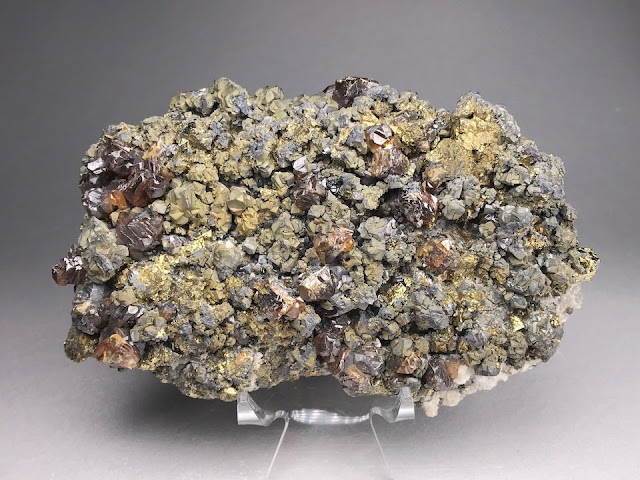尾去沢の方鉛鉱と閃亜鉛鉱 Galena & Sphalerite from Osarizawa
標本幅 width 120 mm / 重さ weight 527 g
径 5 mm ほどの方鉛鉱の群晶に、径 10 mm までの透明感のある閃亜鉛鉱(べっこう亜鉛)が共生する。黄銅鉱と石英をともなう。結晶サイズは小さいが、尾去沢の鉛・亜鉛鉱脈中の晶洞のようすを示す典型的な標本といえるだろう。べっこう亜鉛をよくみると、茶色の濃いもの、オレンジっぽいもの、黄〜緑色っぽいものなど、いろんな色がある。母岩の一部には黒い閃亜鉛鉱がはりついている。はじめ高温の熱水から鉄に富んだ閃亜鉛鉱が固化して、その後ゆっくり冷えて、大粒のべっこう亜鉛が方鉛鉱とともに結晶した、と(シロウトながら)考えるとつじつまが合う。
Galena of 5 mm in diameter crystallizes with translucent sphalerite to 10 mm in diameter and some chalcopyrite and quartz, which will be a typical example from a lead-zinc vein in Osarizawa. The color of sphalerite ranges from dark brown, orange, to yellowish green. Black sphalerite is attached to a part of the base rock, implying that iron-rich sphalerite first solidifies from a high-temperature fluid, and translucent sphalerite and galena at lower temperature.
この鉛・亜鉛鉱を覆うように、さらに黄銅鉱が結晶している。おもしろいのは、方鉛鉱の表面に選択的に薄くふりつもっているところ。この「金メッキ」のような黄銅鉱のつき方は、エピタキシーによるものかもしれない。どういう鉱物の上にどういう鉱物がどんな向きに結晶するかのデータベース(M. Gebhardt, A. Neuhaus, Epitaxy Data of Inorganic and Organic Crystals, 1972)には、以下のような例が記録されている:
Interestingly, chalcopyrite selectively deposits on galena. The thin coating may be caused by epitaxy. A database of epitaxy (M. Gebhardt, A. Neuhaus, Epitaxy Data of Inorganic and Organic Crystals, 1972) describes the following cases of epitaxial growth on chalcopyrite:
| X | 面 plane | 方向 direction |
周期 period [Å] |
誤差 misfit |
|||
|---|---|---|---|---|---|---|---|
| X | Y | X | Y | X | Y | ||
| 方鉛鉱 galena |
(001) | (001) | [100] | [100] | 5.94 | 5.25 | -11.6% |
| 閃亜鉛鉱 sphalerite |
(110) | (001) | [001] | [130] | 5.43 | 4.15 | -23.6% |
| (100) | (100) | [001] | [001] | 10.86 | 10.32 | -5.0% | |
| (111) | (111) | [01-1] | [01-1] | 7.68 | 7.43 | -3.3% | |
一般的に、この表の「誤差」が小さければ小さいほど、エピタキシーが起こりやすいとされる。そうすると黄銅鉱はむしろ閃亜鉛鉱のほうにくっつきやすいようにも解釈できる。そもそも閃亜鉛鉱と黄銅鉱とは結晶構造がほとんどおなじなので、どっちが「仲間」かといえば、やはり閃亜鉛鉱だろう。この標本の方鉛鉱は立方体の面 (100) と八面体の面 (111) の集形で、どちらにも黄銅鉱がついている。黄銅鉱の微粒子が本当におなじ向きにそろっているかどうかは確認できないので、なんとも言えないが、やっぱりエピタキシーではないのかもしれない。一応、黄銅鉱の基盤上に方鉛鉱または閃亜鉛鉱が堆積する例も書き写しておく。ちなみに安四面銅鉱上にも黄銅鉱が薄く層をなして結晶することがある(たとえば前掲の標本)。ネットで検索すると、これはエピタキシーによる、と書かれることが多いようである。
It is generally considered that the less misfit between two mineral species the more tendency that one epitaxially grows on another. Therefore the above numbers suggest chalcopyrite rather tends to grow on sphalerite. Galena in this specimen has cubic (100) and octahedral (111) surfaces and both of them are coated with chalcopyrite. I can't judge if the chalcopyrite crystals on galena are due to epitaxy from appearance. Contrary examples of epitaxic chalcopyrite on a different mineral are shown below.
| Y | 面 plane | 方向 direction |
周期 period [Å] |
誤差 misfit |
|||
|---|---|---|---|---|---|---|---|
| X | Y | X | Y | X | Y | ||
| 方鉛鉱 galena |
(001) | (001) | [100] | [100] | 5.25 | 5.94 | 13.1% |
| (111) | (111) | [1-10] | [1-10] | 3.71 | 4.19 | 12.9% | |
| 閃亜鉛鉱 sphalerite |
(100) | (100) | [001] | [001] | 5.15 | 5.42 | 5.2% |
| (001) | (100) | [100] | [001] | 5.24 | 5.42 | 3.4% | |
| (111) | (111) | [1-10] | [1-10] | 7.42 | 7.66 | 3.2% | |
| (110) | (111) | [1-10] | [1-10] | 7.42 | 7.66 | 3.2% | |



